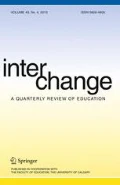Abstract
Next to highly regarded varieties of apprenticeship-based vocational education there are, in many countries, forms of mainly school-based VET (vocational education and training) that suffer from a clash of expectations between schools and workplaces as sites of vocational education. School-based VET is viewed as of lesser value compared to work experience or workplace based training and one reason for such negative views on mainly school-based VET is the lack of authentic work-related experiences in schools. In what follows I will, based on a case study of a social development project, argue that there is a potential hybrid form of school-based VET that could deal with this issue of authenticity by working around the usual binary of school and workplace. This has resulted in some suggestions for how to reconsider vocational education curricula in schools, aiming at authentic learning environments through the systematic enactment of social and cultural developmental projects. The result is not only a way of dealing with the problems that face school-based VET but an argument for how to take advantage of schools being predominantly cultural institutions.
Similar content being viewed by others
Notes
The so-called dual system with four days of workplace based training and one day of school. In the following I will be using the term more generically to refer to any training system where the amount of workplace based learning is greater than the time spent in school.
Eurythmy (a movement art) and Waldorf (Steiner) education both spring from the work of Rudolf Steiner (1861–1925).
The argument is that students experience schooling institutions as inauthentic on account of curricula that generally focus on doing things that matter only within the institution itself. This is not the place to prove or disprove such an assumption (to say nothing of the many different explanations that might be offered) since it is not a central element of what I believe the case can tell us. This is not to say that it is irrelevant, I find it very important, but I am not sure that there is evidence to support what such a curriculum could achieve in this respect on the grounds that there are hardly any such curricula that have been systematically examined from such a perspective (a single case can’t tell us much about it on a general level but for practitioners already struggling with the issue it offers a source of alternative thinking).
References
Berglund, I. (2004). Lärande simulering eller simulerat lärande?. Stockholm: HLS Förlag.
Brater, M., et al. (1988). Berufsbildung und Persönlichkeitsentwicklung. Stuttgart: Verlag Freies Geistesleben.
Brater, M., et al. (2011). Kunst als Handeln – Handeln als Kunst. Was die Arbeitswelt und Berufsbildung von Künstlern lernen können. München: Bertelsmann.
Edding, F., et al. (1985). Praktisches Lernen in der Hibernia-Pädagogik. Stuttgart: Klett-Cotta.
Flyvbjerg, B. (2001). Making social science matter. Cambridge: Cambridge University Press.
Flyvbjerg, B., et al. (2012). Real social science. Applied phronesis. Cambridge: Cambridge University Press.
Gessler, L. (1988). Bildungserfolg im Spiegel von Bildungsbiographien. Frankfurt: Peter Lang Verlag.
Green, A., et al. (2013). Literature review on employability, inclusion and ICT, report 1: the concept of employability with a specific focus on young people, older workers and migrants. European Commission: JRC Technical Report.
Griffiths, M., & Macleod, G. (2008). Personal narratives and policy: never the twain? Journal of Philosophy of Education, 42(S1), 121–143.
Hamilton, S., & Lempert, W. (1996). The impact of apprenticeship on youth: a prospective analysis. Journal of Research on Adolescence, 6(4), 427–455.
Hetland, L., et al. (2007). Studio thinking: the real benefits of visual arts education. New York: Teacher College Press.
Kaplan, A. (1996). The development practitioners’ handbook. Cape Town: Pluto Press.
Larsson, S. (2009). A pluralist view of generalization in qualitative research. International Journal of Research & Method in Education, 32(1), 25–38.
Lundahl, L., et al. (2010). Setting things right. Swedish upper secondary school reform in a 40 year perspective. European Journal of Education, 45(1), 46–59.
Nijhof, W., & Streumer, J. (Eds.). (1998). Key qualifications in work and education. Dordrecht: Kluwer Academic Publishing.
OECD. (2010). Learning for jobs: OECD policy review of vocational education and training.
Olofsson, J., & Panican, A. (Eds.). (2008). Ungdomars väg från skola till arbetsliv, Nordiska erfarenheter. Köpenhamn: Nordiska ministerrådet.
Rist, G., & Schneider, P. (1979). Integrating vocational and general education: a Rudolf Steiner school. Hamburg: Unesco institute for education.
Rittelmeyer, C. (2012). Warum und wozu ästhetische Bildung?. Oberhausen: Athena.
Schmalenbach, B. (2011). Kunst in der Ausbildung sozialer Berufe. München: Kopaed.
Schön, D. (1987). Educating the reflective practitioner. San Francisco: Jossey-Bass Publishers.
Schram, S. (2012). Phronetic social science: an idea whose time has come. In B. Flyvbjerg, et al. (Eds.), Real social science. Applied phronesis (pp. 15–26). Cambridge: Cambridge University Press.
Soal, S. (2003). Holding infinity—Guiding social processes. Cape Town: CDRA.
Stäudel, L. (2010). Kompetenzorientiert unterrichten: Aufgaben gestalten, Ethik & Unterricht, No 1 2010.
Taylor, J. (2003). Organizations and development—Towards building a practice. Cape Town: CDRA.
Thomas, G. (2010). Doing case study: Abduction not induction, phronesis not theory. Qualitative Inquiry, 16(7), 575–582.
Tyson, R. (2014). Aesthetic Bildung in vocational education: the biographical case of bookbinding master Wolfgang B. and his apprenticeship. Vocations and Learning, 7(3), 345–364.
Tyson, R. (2015). Vocational Bildung in action. Licentiate dissertation: Stockholm University.
With, A. G. (1994). A reconstituted general education: the integration of the vocational and the liberal. Journal of Curriculum Studies, 26(6), 593–600.
Author information
Authors and Affiliations
Corresponding author
Rights and permissions
About this article
Cite this article
Tyson, R. When Expectations Clash: Vocational Education at the Intersection of Workplace and School. Interchange 47, 51–63 (2016). https://doi.org/10.1007/s10780-015-9271-5
Received:
Accepted:
Published:
Issue Date:
DOI: https://doi.org/10.1007/s10780-015-9271-5




